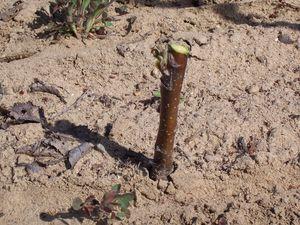Planning Your Orchard
The "Short and Sweet" from Grandpa:
• The "Nursery Cycle" takes several years of careful planning and good guessing before you can buy a fruit tree!
• You also need to take a little time and effort to plan
• Satisfy your taste buds!
• Pedestrian orchard or a little climbing?
• High maintenance or lower maintenance training systems?
• Your site may already be chosen, but you can tweak what you want to grow on your site.
• Pollination--- keeping the bees involved.
• Conventional or organic growing?
Grandpa's "long winded" answer:
Grandpa wasn't just a fruit grower. He was a fruit tree salesman for over 50 years, too! He understood the need for good planning from both sides.
The "Nursery Cycle": Sometimes, Grandpa only needed to plan his orchards a few months ahead if the varieties he wanted were readily available, but, Grandpa always had sympathy for his nurseryman friends who grew fruit trees, because they had always had to look into their "crystal ball" and foresee several years into the future what they were going to sell. This is the "nursery cycle". Fruit trees don't grow from seed, but from "asexually" propagated plant parts!
• Fruit tree rootstocks, for dwarf apple, pear and cherry, are propagated from specially bred varieties or cultivars that took scientists and breeders tens of years to develop and evaluate before they became successfully used by commercial growers. 15-30 years is not unheard of.
• Even seedling rootstocks used for many standard size peach, nectarine, plum, prune, apricot and cherry take years to evaluate from their initial selections as a single seedling to a possible rootstock that has good horticultural traits.
• It usually takes a year or two for a seedling or rootstock nursery to produce a rootstock that it can sell to a fruit tree nursery that will propagate a specific variety on it.
• Only then, in the FIRST spring, can a fruit tree nursery: o buy the rootstock from a rootstock nursery, o plant it in their field, o bud it that coming summer,
- over-winter it as a dormant bud on the rootstock
- then, the SECOND following spring
- allow the bud of the fruit variety to start growing into a tree
- water, fertilize, spray and nurture it all summer
- dig and harvest it as a bareroot tree in the fall
- grade and store it in cold storage all winter
• and finally in the THIRD spring sell and deliver it to you! Two complete years from start to finish!
• Unless, they had a specific order for a particular variety / rootstock combination, they have done all of this on what everyone would call a "good guess". Farmers are real risk takers!
• Even developing a new variety of fruit is a long term project that can take anywhere from 5 to 40 years before a new variety is well accepted into the market place.
Here are some important points for YOU to ponder: If it takes the nurseryman all these years of planning to come up with a fruit tree for your backyard, then it seems only just you should take a little time to plan ahead! Most of these points are covered in more detail in separate, specific growing tips.
Chose your varieties with care:
• Do I have a sweet tooth or do I like tart?
• Do I like soft fruit or are my teeth still good enough for hard, crisp apples?
• Red, yellow, green, orange, gold, sooooo many colors!
• You get the point, right? How big a ladder do I want to buy? Unless you buy a fully dwarf tree, you probably are going to have to do a little bit of climbing. Not all varieties are available for a totally "pedestrian" tree on fully dwarf roots, and not all fully dwarf roots are suitable for the backyard fruit grower's soil or site.
In general, most semi-dwarf apples, cherries and pears, and most standard peach, nectarine, plums and prunes can be pruned and maintained in a small enough tree form that you should not have to climb more than a few feet off the ground to get to most of the fruit. Apricots and cherries on seedling roots will be a little more of a challenge to keep down.
Training systems and rootstocks usually go hand in hand. Semi-dwarf trees require a little different management system than fully dwarf ones. Site Selection: Will the rootstocks you want grow in your soil? What hardiness zone are you in? Are you planting at the top or bottom of a hill? Are you on flat ground? Pollination?
• Does the variety you want to grow require a pollinator or is it self-fruitful?
• What other varieties will meet these pollination needs?
• Are they early, mid-season, or late blooming? Conventional or Organic? Are you determined to grow totally organic, or are you less concerned about having to spray a little?
